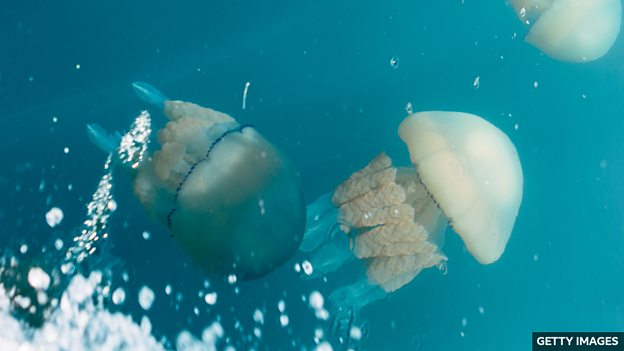根据英国海洋环境保护协会的一项调查显示,过去一年,人们在英国的海域中和海滩上发现的水母数量增加了 32% 。最多见的是巨型桶水母,但也有人看到过更少见的暖水性水晶果冻水母。
Most of these jellyfish sightings reported to the Marine Conservation Society were in Cornwall and off the west coast of Wales. The most commonly seen was the large barrel jellyfish with a bulbous head, which can measure up to a metre wide, and eight frilled legs – it can be shocking to spot at close quarters.
人们向英国海洋环境保护协会报告的目击水母的地点大多是在康沃尔郡以及威尔士西海岸附近。最多见的是巨型桶水母,它的头部呈球茎状,头宽可达一米,还有八条褶边状的触手 —— 在近距离看到这种水母可能会令人感到很震撼。
Jellyfish populations do go through boom-and-bust cycles naturally, but climate change is also changing UK seas. A marine heatwave in June temporarily pushed up temperatures by around four degrees. The Marine Conservation Society and other experts say more research is needed to understand the precise link to climate change.
虽然水母数量本就会经历自然的周期性增长,但气候变化也在改变英国海洋和海洋生物。今年六月的海洋热浪将海水温度暂时性地提升了约四度。英国海洋环境保护协会和一些专家表示还需作进一步研究以了解水母数量增加与气候变化的确切联系。
词汇表
sightings 看见,目击
off the coast of 在…海岸附近
bulbous 球茎状的
frilled 褶边的
close quarters 近距离
boom-and-bust cycles “盛衰周期”,(动物数量的)周期性增长
heatwave 高温热浪
pushed up 提升了
precise 确切的,精准的
阅读理解:请在读完上文后,回答下列问题。
1. Where have most of the jellyfish been seen?
2. What do large barrel jellyfish look like?
3. True or false? Boom-and-bust cycles are unusual for jellyfish populations.
4. Why did sea temperatures increase by around four degrees in June?
答案
1. Where have most of the jellyfish been seen?
Most of these jellyfish sightings reported to the Marine Conservation Society were in Cornwall and off the west coast of Wales.
2. What do large barrel jellyfish look like?
They have a bulbous head, which can measure up to a metre wide, and eight frilled legs.
3. True or false? Boom-and-bust cycles are unusual for jellyfish populations.
False. Jellyfish populations do go through boom-and-bust cycles naturally.
4. Why did sea temperatures increase by around four degrees in June?
A marine heatwave in June temporarily pushed up temperatures by around four degrees.

